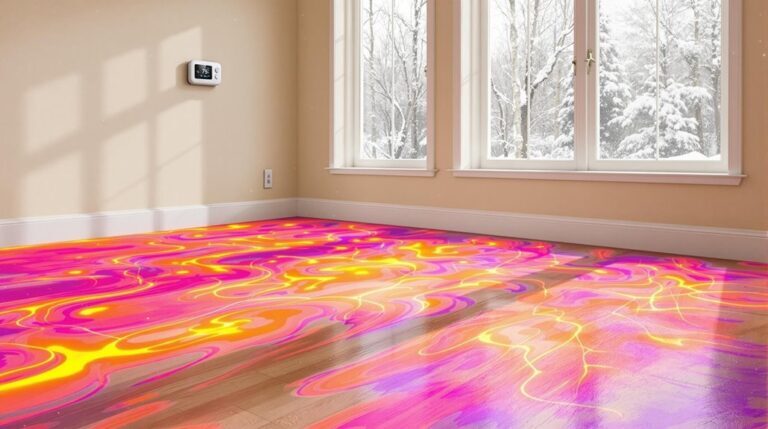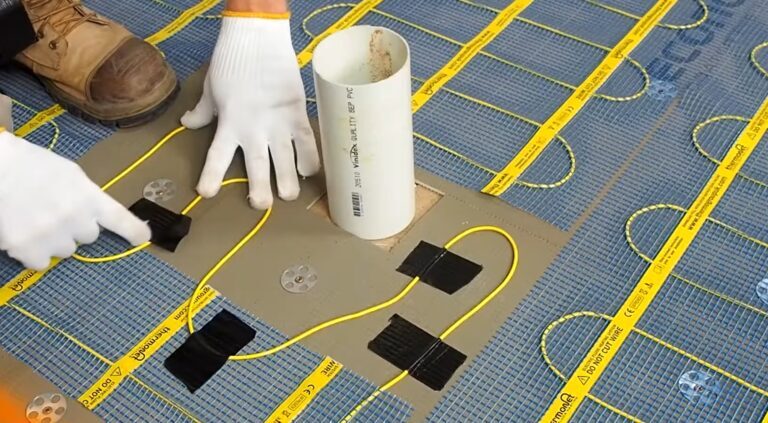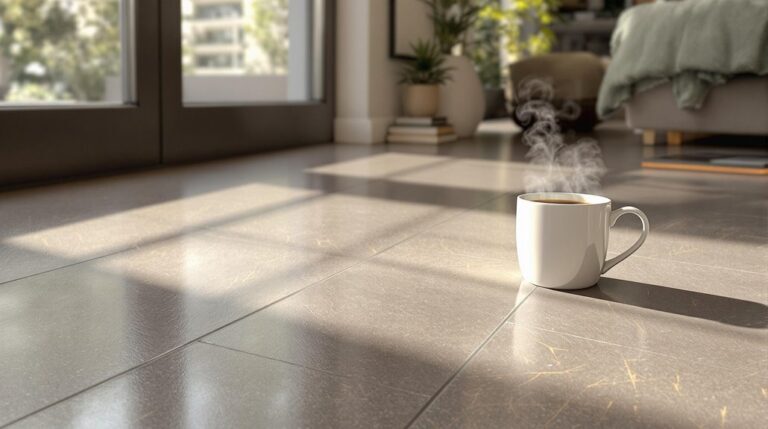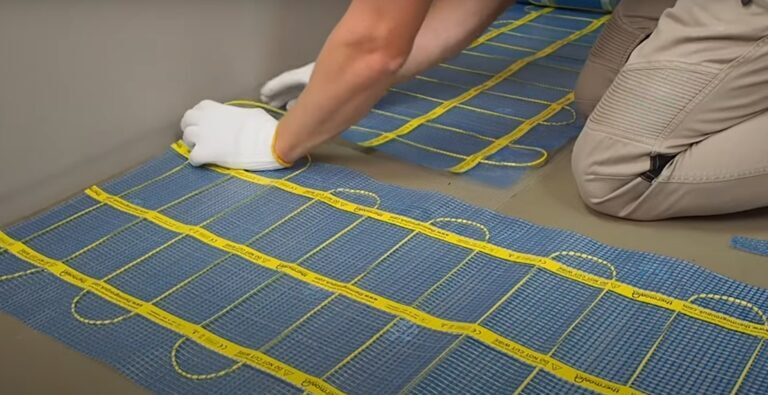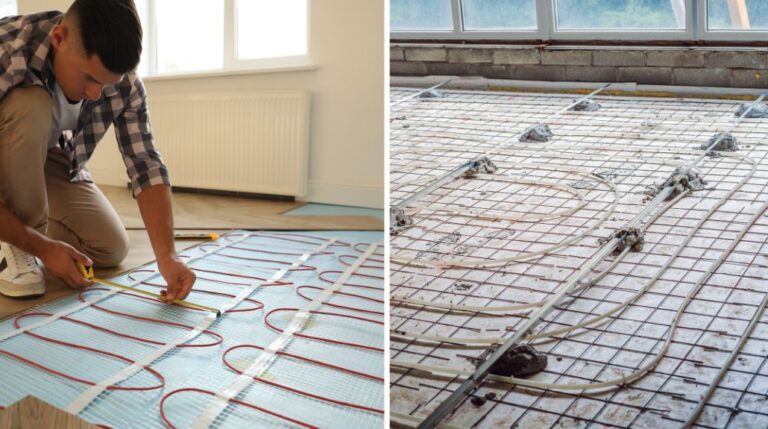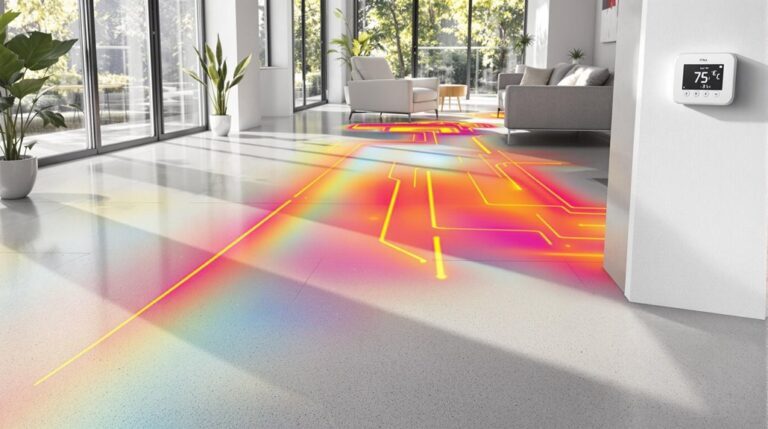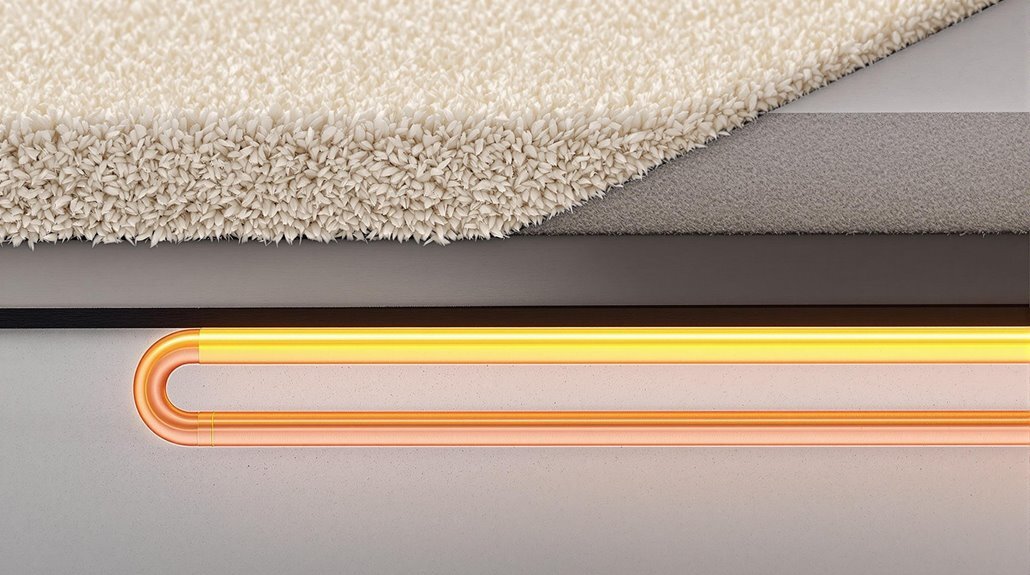
If you’re considering underfloor heating beneath your carpet, you’ll be pleased to know it’s not only possible but can be highly effective when done correctly. The combination offers the best of both worlds: the cozy comfort of carpet with efficient, even heating throughout your space. However, success depends on several vital factors, from choosing the right carpet type to proper installation methods. Understanding these elements will help you avoid common pitfalls that could compromise your heating system’s performance and guarantee you achieve the warm, comfortable flooring solution you’re seeking.
Key Takeaways
- Yes, underfloor heating is compatible with carpet, provided the combined carpet and underlay TOG rating doesn’t exceed 2.5.
- Low-pile carpets and synthetic fibers like nylon work best with underfloor heating, offering excellent heat conductivity.
- Specialized underlays designed for underfloor heating are essential to maintain efficient heat transfer through the carpet.
- Carpets can enhance heating efficiency by acting as natural insulators, reducing heat loss by 10-20%.
- Proper installation and material selection ensure optimal performance while maintaining comfort and energy efficiency.
Benefits of Carpet Underfloor Heating
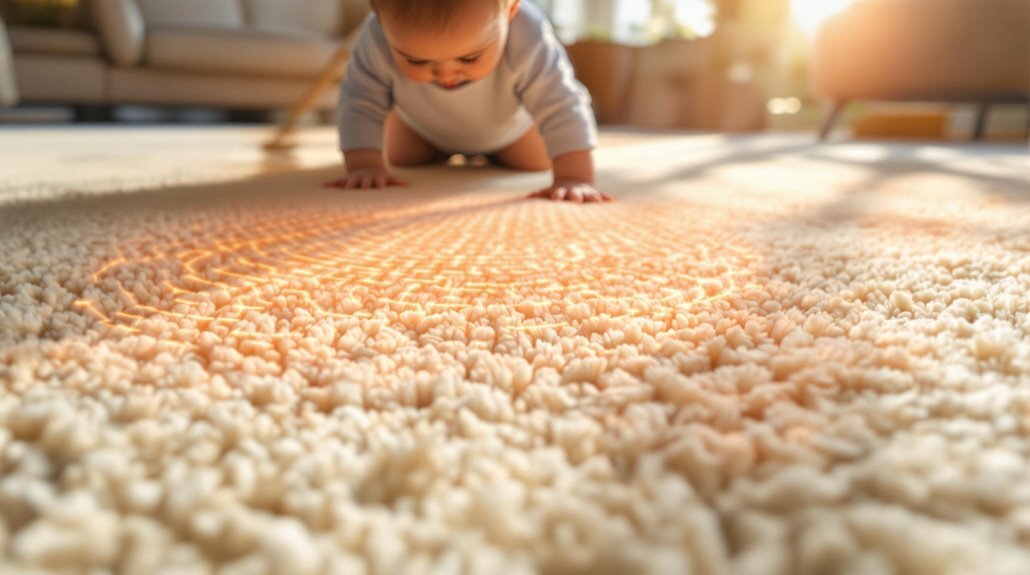
Having installed underfloor heating systems across Sydney for over a decade, I’ve seen firsthand how carpeted floors with heating offer unmatched comfort and efficiency.
When you combine carpet with underfloor heating, you’re creating a powerful duo that maximizes both warmth and energy savings in your home.
The thermal insulation properties of carpet work harmoniously with underfloor heating to create an efficient heating system. Your carpet acts as a natural insulator, helping to retain heat and reduce loss by 10-20% compared to uncarpeted floors.
This means you’ll spend less on heating costs – up to 13% less in many cases – while maintaining consistent warmth throughout your space.
What’s particularly impressive is how wool carpets enhance heat retention. They create a cozy environment where you’ll feel comfortable even at lower air temperatures.
Unlike traditional heating methods that can create uncomfortable drafts, underfloor heating distributes warmth evenly from the ground up, eliminating cold spots and providing consistent comfort throughout your room.
The system’s energy efficiency is further enhanced by its zoned heating capabilities. You can control different areas independently, focusing warmth exactly where you need it.
This targeted approach not only improves comfort but also reduces energy consumption.
Plus, the combination helps maintain lower humidity levels, creating a healthier living environment by reducing dust mites and allergens.
It’s a practical solution that delivers both comfort and efficiency for your Sydney home.
Choosing the Right Carpet for Underfloor Heating
Three critical factors determine whether your carpet will work effectively with underfloor heating: thermal resistance, material type, and thickness.
When selecting your carpet, you’ll need to pay attention to its Tog rating, which measures how well it resists heat flow. For ideal performance, guarantee the combined Tog rating of your carpet and underlay doesn’t exceed 2.5.
The thickness of your carpet directly impacts heat transfer efficiency. Low-pile carpets are your best choice, as they allow heat to pass through more effectively than thick, high-pile options. You’ll want to avoid dense, plush carpets that can act as insulators and reduce your system’s effectiveness.
When it comes to materials, both natural and synthetic fibers can work well. Synthetic fibers like nylon are particularly good choices due to their excellent heat-conductive properties. Look for carpets with hessian backing, as they allow better heat permeation through the floor surface.
Don’t forget about the underlay – it’s just as important as the carpet itself. Choose a specialized underlay designed specifically for underfloor heating systems. These underlays have lower thermal resistance and won’t obstruct heat flow like traditional thick underlays might.
The right combination of carpet and underlay will guarantee your heating system operates at peak efficiency.
Remember to always check the manufacturer’s guidelines for compatibility with underfloor heating. Your carpet’s surface temperature shouldn’t exceed 27°C (80°F) for safe and efficient operation.
Best Practices for Installing Underfloor Heating Under Carpet
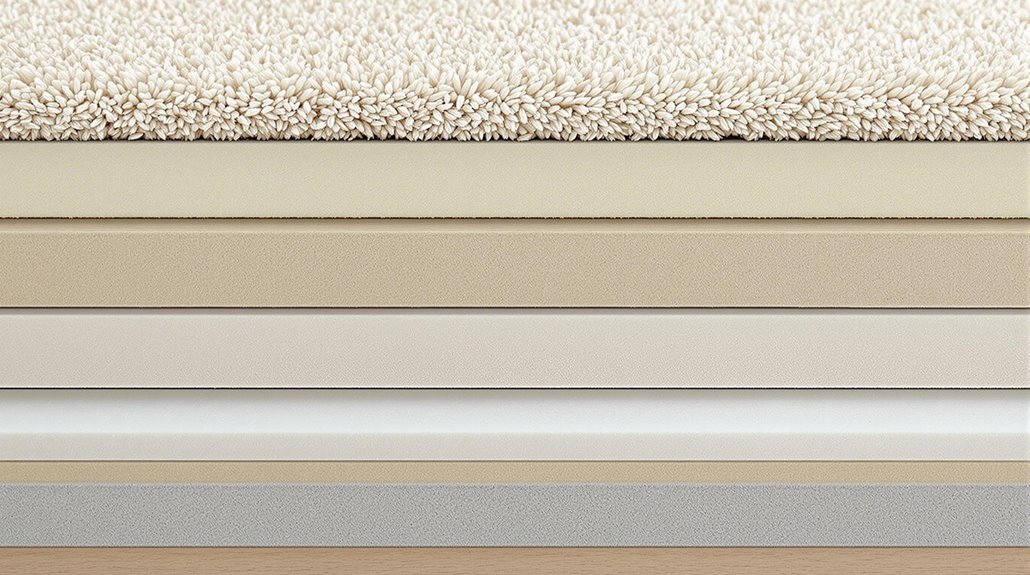
Proper installation lies at the heart of a successful underfloor heating system under carpet. At Floor Heating Today, we’ve found that meticulous preparation of your base layer is imperative – it must be clean, dry, and perfectly level before any installation begins.
When installing underfloor heating under carpet, you’ll need to carefully plan the system layout to guarantee efficient heat distribution. We recommend installing an insulation layer beneath the heating elements to prevent heat loss and direct warmth upward.
Remember, the combined thermal resistance of your carpet and underlay shouldn’t exceed 2.5 Tog for peak performance.
Safe electrical connection is non-negotiable. You’ll need a qualified electrician to connect your system following the manufacturer’s guidelines. Our installation teams work meticulously to follow the planned layout, preventing costly errors and guaranteeing even heat distribution throughout your space.
Temperature regulation is crucial for protecting both your carpet and heating system. Don’t let your floor temperature exceed 27°C (80°F), and make sure you’re using appropriate controls to maintain consistent warmth.
We’ll help you select the right insulation for efficiency, whether that’s insulation boards or specialized underlay.
After installation, it’s important to test your system thoroughly. We’ll verify even heat distribution and check that everything’s working at peak efficiency.
You’ll need to maintain your system with regular vacuuming to prevent dust build-up, and we recommend scheduling periodic maintenance checks to guarantee your carpet heating system continues performing efficiently for years to come.
Essential Carpet Underlay for Underfloor Heating Systems
When it comes to underfloor heating beneath carpet, choosing the right underlay isn’t just important – it’s vital for system efficiency. At Floor Heating Today, we’ve found that the key factor is selecting underlays with low thermal resistance. Your underlay must allow efficient heat flow while still providing essential cushioning and insulation properties.
The combined tog rating of your carpet and underlay shouldn’t exceed 2.5. This requirement guarantees ideal heat transfer from your underfloor heating system to your living space. We recommend specialized underlays designed specifically for underfloor heating systems, which often feature perforated holes for better air circulation and heat distribution.
For the best results with underfloor heating, follow these essential requirements:
- Choose underlays with an R-value below 1.42 and a U-value above 4.0 to maintain efficient heat transfer.
- Select perforated underlays that allow proper air circulation while maintaining durability and noise reduction properties.
- Pair your underlay with low-pile carpets or those featuring hessian backing for maximum system effectiveness.
- Avoid rubber-backed carpets and thick, dense underlays that can block heat flow.
The right combination of underlay and carpet is vital for system performance. We’ve found that synthetic fibers work particularly well, as they conduct heat more effectively than some alternatives.
When selecting your underlay, focus on products specifically designed for underfloor heating – they’ll provide the perfect balance of comfort, durability, and thermal efficiency your system needs.
Maximizing Heat Distribution and Performance with Floor Heating
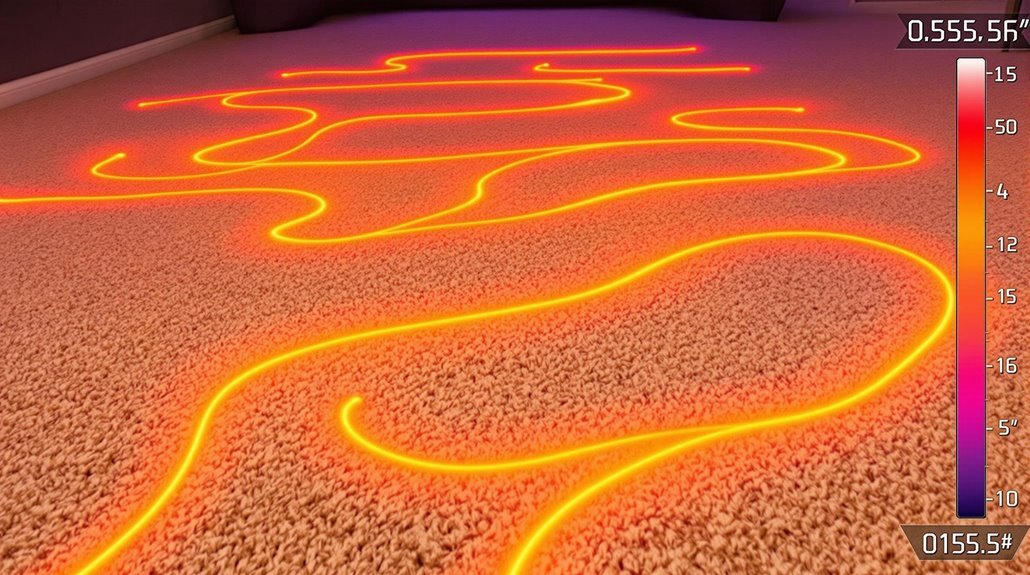
Heat distribution and efficiency lie at the heart of successful underfloor heating installations beneath carpet. Based on our extensive experience at Floor Heating Today, we’ve found that carpet thickness plays an essential role in how effectively heat travels through your flooring. You’ll want to choose thinner, low-pile carpets that allow heat to dissipate evenly throughout your room.
When it comes to thermal resistance, you’ll need to pay careful attention to the combined tog rating of your carpet and underlay. We recommend keeping this value below 2.5 tog, or even better, under 1.5 tog if you’re using a heat pump system. This guarantees ideal heat distribution and prevents your underfloor heating from working harder than necessary.
Proper underlay selection is equally important for maintaining system efficiency. You’ll need specialized underlays designed specifically for underfloor heating, as these products offer lower thermal resistance and work in harmony with your heating system.
We’ve seen remarkable efficiency benefits when customers choose the right combination – their rooms heat up faster and maintain temperature more consistently.
For the best performance, we recommend synthetic fiber carpets with hessian backing, as they conduct heat more effectively than natural fibers. You should avoid carpets with rubber backing or thick insulating materials, as these can greatly impair heat flow.
When installed correctly with these considerations in mind, your underfloor heating system will deliver even, gentle warmth throughout your space while operating at lower temperatures than traditional heating methods, ultimately saving you energy and money.
Common Carpet Underfloor Heating Challenges and How to Solve Them
The successful integration of underfloor heating with carpet comes with its fair share of challenges, but they’re all surmountable with the right approach. The main concern is thermal resistance, where thick carpets can act as insulators and reduce your system’s efficiency.
We’ve found that many homeowners overlook the importance of TOG ratings, which measure the carpet and underlay’s thermal resistance.
To guarantee peak performance, you’ll need to take into account these vital solutions:
- Choose low-pile carpets with a combined TOG rating (carpet plus underlay) below 2.5
- Select specialized underlays designed specifically for underfloor heating systems
- Confirm proper installation by certified professionals to avoid common pitfalls
- Use hessian-backed carpets for better heat distribution
When designing your underfloor heating system, it’s essential to factor in the specific characteristics of your chosen floor covering.
We recommend selecting carpets with lower thermal resistance values to maximize heat transfer efficiency. Remember that proper installation is key – even the best materials won’t perform at their best if they’re not installed correctly.
At Floor Heating Today, we’ve found that many efficiency issues can be resolved by simply choosing the right materials.
Thick or dense underlays are often the culprit behind poor system performance. By focusing on appropriate product selection and professional installation, you can enjoy the comfort of carpet without compromising your underfloor heating system’s effectiveness.
Reducing Heating Costs with an Efficient Underfloor Heating System
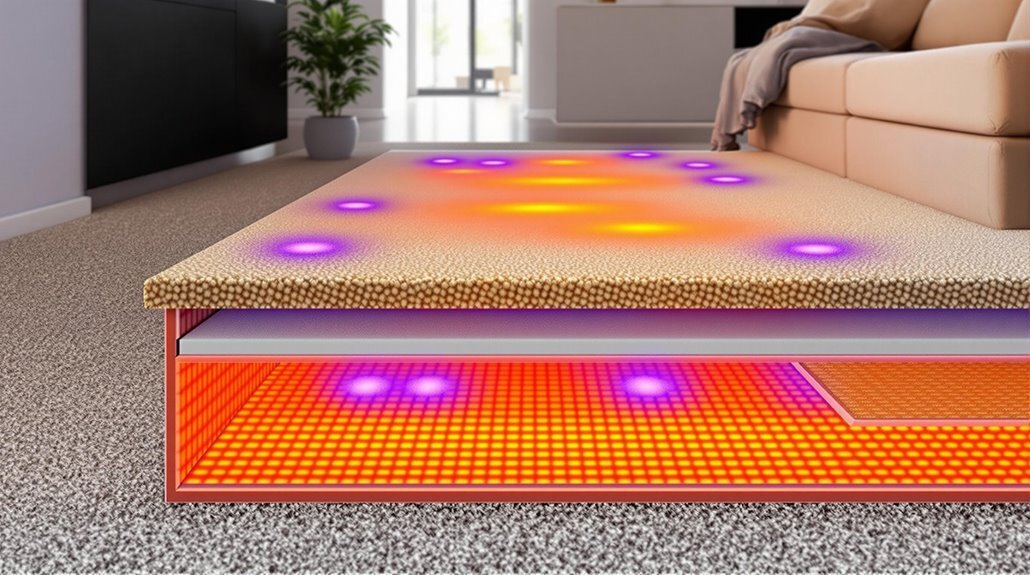
Since energy costs continue to rise across Sydney, understanding the financial implications of underfloor heating systems has become essential for homeowners. At Floor Heating Today, we’ve found that while initial system costs may seem substantial, the long-term energy efficiency benefits often justify the investment, especially when installed under carpet.
| System Type | Initial Cost (per sq ft) | Energy Efficiency Rating |
|---|---|---|
| Electric | $7.90 – $15.00 | Good |
| Hydronic | $6.00 – $20.00 | Excellent |
| Solar | $3.30 – $8.10 | Outstanding |
When you’re reflecting on underfloor heating installation under carpet, you’ll need to factor in both system costs and additional expenses. A whole-home electric system typically ranges from $19,000 to $36,000, while hydronic systems can cost between $14,000 and $48,000. However, these costs can vary based on your specific requirements and property size.
The good news is that proper installation and material selection can maximize your energy savings. Low-thermal resistance carpet and underlay combinations work best with underfloor heating systems, improving heat distribution and reducing energy waste. You’ll also need to think about supplementary costs such as thermostats ($100-$400) and labor ($550-$2,500), but these investments contribute to the system’s overall efficiency.
For greatest cost-effectiveness, we recommend choosing a system that matches your space requirements. Hydronic systems prove more energy-efficient for larger areas, while electric systems work better for smaller spaces. When properly installed under carpet, these systems can provide significant savings on your heating bills while maintaining ideal comfort levels.
Get Professional Help Today
Choosing the right floor heating system for your carpeted room ensures efficient heat output and year-round comfort. Whether you’re installing a heat mat for electric underfloor heating or layering a radiant setup with two layers of insulation, proper material selection is key. From aluminum foil insulation to carpet heaters, we provide expert solutions tailored to your needs. Don’t settle for an inefficient radiator—upgrade to a suitable for underfloor heating solution. Transform your bedroom, tile, or living space with a premium mat system. Contact us today at Floor Heating Today for professional installation in Sydney!


